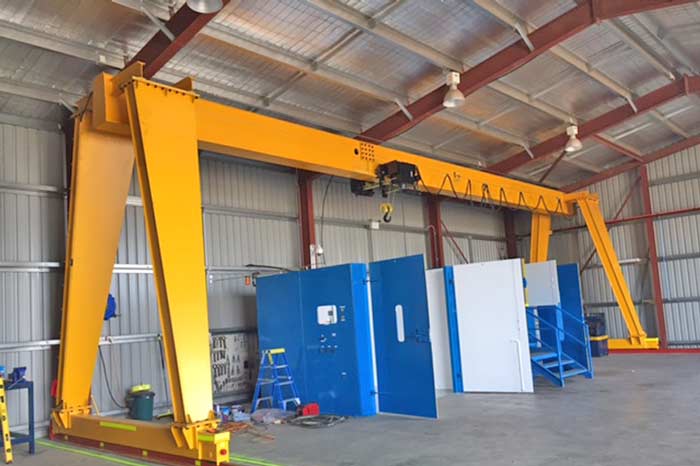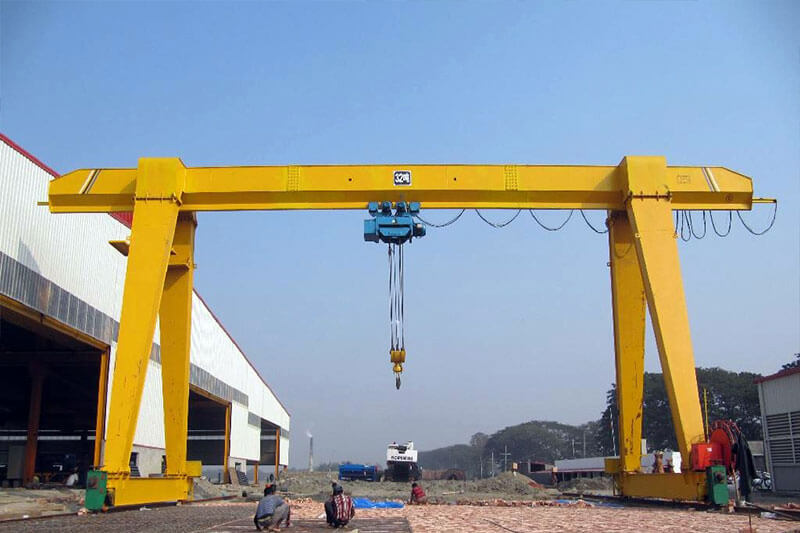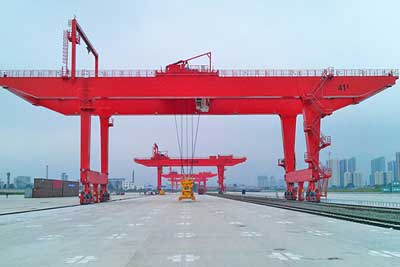Single Girder vs. Double Girder Gantry Cranes Cost Comparison
Comparing the Cost of Single Girder vs. Double Girder Gantry Cranes
In the various industry and construction, efficiency and precision are paramount. Among the many tools and machinery that facilitate these endeavors, gantry cranes stand as vital workhorses. These gantry cranes with their remarkable lifting capabilities, play a pivotal role in various industries, from manufacturing to shipping, enabling the movement of heavy loads with ease. However, not all gantry cranes are created equal. The choice between a single girder and a double girder gantry crane can significantly impact a project's cost, performance, and overall success. In this article, we delve into the intriguing comparison of these two crane types, exploring their features, advantages, limitations, and, most importantly, their costs. By the end, you'll have a clearer understanding of which crane is the right fit for your specific needs, be it for a large-scale industrial operation or a smaller-scale project. So, let's hoist the curtain on the great crane debate and discover which one might be the perfect lift for your endeavors.
What Are Gantry Cranes and Their Common Applications?
Before we delve deeper into the comparison of single girder and double girder gantry cranes, let's ensure we have a solid grasp of what gantry cranes are and where they find their applications. Gantry cranes are a class of overhead crane characterized by their tall, freestanding framework, which supports a horizontal beam (known as the girder) for lifting and moving heavy loads. These cranes are known for their versatility and are utilized in a wide range of industries and applications.
Common applications of gantry cranes include:
- 1. Manufacturing: Gantry cranes are often used in manufacturing facilities for tasks such as lifting and positioning heavy machinery, materials, and components.
- 2. Warehousing and Logistics: In warehouses and distribution centers, gantry cranes help with loading and unloading cargo containers and managing inventory.
- 3. Construction: Construction sites frequently employ gantry cranes to lift construction materials like steel beams, concrete blocks, and pre-fabricated structures.
- 4. Shipbuilding: The shipbuilding industry relies heavily on gantry cranes for assembling large ship sections and moving ship components.
- 5. Railway Maintenance: Gantry cranes are instrumental in railway yards for lifting and positioning locomotives, railway cars, and maintenance equipment.
- 6. Aerospace: In the aerospace sector, gantry cranes are used to move and position aircraft components during manufacturing and assembly.
- 7. Ports and Harbors: Gantry cranes at ports and harbors load and unload containers from ships and transport them to storage areas or trucks.
The Importance of Selecting the Right Type of Gantry Crane
The world of gantry cranes is diverse, offering various types and configurations to cater to specific tasks and environments. Choosing the appropriate type of gantry crane is crucial for several reasons:
- 1. Efficiency: Selecting the right crane ensures that lifting operations are carried out efficiently, reducing downtime and increasing productivity.
- 2. Safety: Different tasks require different safety features and load capacities. The right gantry crane minimizes the risk of accidents and injuries.
- 3. Cost-effectiveness: An optimal choice prevents unnecessary expenses, such as overinvesting in a crane with more capacity than needed or incurring high maintenance costs.
- 4. Longevity: Matching the crane to the task helps extend its lifespan and ensures it performs reliably over the years.
In the following sections, we will explore two prominent types of gantry cranes: single girder and double girder gantry cranes, and analyze their features, advantages, and limitations to help you make an informed decision for your specific needs.
Single Girder Gantry Cranes
Design and Construction of Single Girder Gantry Cranes
Single girder gantry cranes are a common choice in various industries due to their practical design and construction. They consist of the following key components:
- 1. Girder: The girder, as the name suggests, is a single horizontal beam that spans the width between the two vertical legs of the gantry crane. This girder supports the lifting equipment, such as a hoist or trolley.
- 2. Legs: The legs of a single girder gantry crane are vertical columns that provide stability and support to the entire structure. They are firmly anchored to the ground and may be equipped with wheels for mobility in some cases.
- 3. Hoisting Mechanism: This component consists of a hoist, which is responsible for lifting and lowering loads, and a trolley that moves horizontally along the girder to position the load.
Advantages of Single Girder Gantry Cranes
Single girder gantry cranes offer several advantages that make them a preferred choice in many situations:
- 1. Lower Initial Cost: One of the most significant advantages of single girder gantry cranes is their affordability. They are generally more cost-effective to purchase and install compared to double girder cranes, making them an attractive option for businesses with budget constraints.
- 2. Easier Installation and Maintenance: Single girder gantry cranes are relatively simpler in design, which makes them easier to install and maintain. This simplicity translates to lower maintenance costs over time.
Limitations of Single Girder Gantry Cranes
Despite their advantages, single girder gantry cranes come with certain limitations:
- 1. Lower Load Capacity: Single girder gantry cranes have a lower load-carrying capacity compared to their double girder counterparts. This restricts their use in situations where heavy lifting is required.
- 2. Limited Span: The span (the distance between the legs) of single girder gantry cranes is limited, which means they may not be suitable for applications requiring a more extensive working area or larger spans.
In the next section, we will explore double girder gantry cranes, their design, advantages, and limitations, providing you with a comprehensive comparison to help you make an informed decision when choosing the right crane for your specific needs.
Double Girder Gantry Cranes
Design and Construction of Double Girder Gantry Cranes
Double girder gantry cranes are known for their robust design and high load-carrying capacity. Their construction includes the following key components:
- 1. Two Girders: As the name suggests, double girder gantry cranes have two horizontal beams (girders) that span the width between the vertical legs. These girders provide increased stability and load-bearing capability.
- 2. Legs: Similar to single girder cranes, double girder gantry cranes have vertical legs that support the entire structure. These legs are anchored firmly to the ground and can also be equipped with wheels for mobility.
- 3. Hoisting Mechanism: The hoisting mechanism of a double girder gantry crane consists of a hoist and trolley, similar to single girder cranes, but with the capacity to handle significantly heavier loads.
Advantages of Double Girder Gantry Cranes
Double girder gantry cranes offer several advantages, making them suitable for heavy-duty applications:
- 1. Higher Load Capacity: Perhaps the most notable advantage of double girder gantry cranes is their ability to handle much heavier loads compared to single girder cranes. This makes them indispensable in industries where lifting massive objects is routine.
- 2. Longer Span: Double girder cranes have a longer span between the legs, providing a larger working area. This extended span allows them to cover more ground, making them ideal for applications that require a broad coverage area.
Limitations of Double Girder Gantry Cranes
While double girder gantry cranes excel in many aspects, they do come with their own set of limitations:
- 1. Higher Initial Cost: The robust construction and higher load capacity of double girder gantry cranes come at a cost. They tend to have a higher initial purchase price compared to single girder cranes.
- 2. More Complex Installation and Maintenance: Double girder gantry cranes are more complex in design, which can make their installation and maintenance more involved and costly. This complexity may also result in longer downtimes during maintenance activities.
In the following section, we will conduct a cost comparison between single girder and double girder gantry cranes to help you make an informed decision based on your specific needs and budget constraints.
Cost Comparison
Analyze the Initial Cost of Purchasing and Installing Single Girder vs. Double Girder Gantry Cranes
When choosing between single girder and double girder gantry cranes, one of the most critical factors to consider is the initial cost. Let's break down the cost aspects of both types:
- Single Girder Gantry Cranes: - Lower Initial Cost: Single girder gantry cranes are generally more affordable to purchase and install. Their simpler design and reduced material requirements contribute to a lower upfront investment.
- Double Girder Gantry Cranes: - Higher Initial Cost: Double girder gantry cranes come with a higher initial price tag due to their heavier construction and increased load capacity. They often require more substantial foundations and structural support, which can add to the installation cost.
Consider the Long-Term Cost Implications, Including Maintenance and Operational Costs
While the initial cost is a crucial factor, it's equally important to consider the long-term cost implications of your gantry crane choice:
Single Girder Gantry Cranes:
- Lower Maintenance Costs: Single girder cranes tend to have simpler designs, which can translate to lower maintenance costs over their lifespan.
- Lower Operational Costs: These cranes are often more energy-efficient and cost-effective to operate, making them economical choices for businesses with limited budgets.
Double Girder Gantry Cranes:
- Higher Maintenance Costs: The complexity of double girder cranes may result in higher maintenance costs over time. Specialized technicians and more frequent inspections may be required.
- Higher Operational Costs: Double girder cranes, especially when handling heavy loads, may consume more energy and have higher operational costs.
Provide a Cost-Benefit Analysis of Each Type
To make an informed decision, it's crucial to conduct a cost-benefit analysis based on your specific needs:
Single Girder Gantry Cranes:
- Benefits: Lower upfront cost, easier installation and maintenance, suitable for lighter loads and shorter spans.
- Ideal For: Small to medium-sized businesses with budget constraints, tasks requiring moderate load capacities.
Double Girder Gantry Cranes:
- Benefits: High load capacity, longer span, suitable for heavy-duty applications.
- Ideal For: Industries with heavy lifting requirements, long-term cost considerations, and larger working areas.
Ultimately, the choice between single girder and double girder gantry cranes should align with your project's demands and budget constraints. Evaluating both the initial cost and long-term cost implications, along with the specific operational requirements of your business or project, will help you select the optimal crane for your needs. In the next section, we will explore the key factors that influence the decision between these crane types, offering further guidance for your choice.
Factors Influencing the Choice
Factors That Influence the Decision Between Single Girder and Double Girder Gantry Cranes
Choosing between single girder and double girder gantry cranes should be a well-informed decision based on various factors that are specific to your application. Here are key factors to consider:
1. Load Requirements:
- Single Girder: If your lifting needs are moderate and involve loads within the range of a single girder crane's capacity, opting for a single girder crane makes economic sense.
- Double Girder: When your application requires lifting heavy loads, well beyond the capacity of single girder cranes, or if you need precise control over the load, a double girder crane is the suitable choice.
2. Span and Workspace:
- Single Girder: For applications with limited space and shorter spans between the legs, single girder cranes are practical due to their compact design.
- Double Girder: If your workspace is large, and you require an extended span to cover a broader area, double girder cranes offer the necessary reach.
3. Budget Constraints:
- Single Girder: When you have budget constraints or need a cost-effective solution, single girder cranes present an attractive option with their lower initial cost.
- Double Girder: If your budget allows for a larger upfront investment and you anticipate long-term cost benefits or require the higher capacity and span of a double girder crane, it may be a worthwhile investment.
Guidance on How to Assess These Factors to Make an Informed Choice
To make a well-informed choice between single girder and double girder gantry cranes, follow these steps:
1. Evaluate Load Requirements:
- Calculate the heaviest loads you'll need to lift regularly.
- Consider potential future load requirements, allowing for growth in your operations.
2. Assess Span and Workspace:
- Measure the available space in your facility or at the worksite.
- Determine the required span between the crane legs to ensure full coverage of your workspace.
3. Consider Budget Constraints:
- Establish a clear budget for your crane investment, including installation costs.
- Weigh the upfront costs of both crane types against your long-term operational and maintenance savings.
4. Seek Expert Advice:
- Consult with crane manufacturers or specialists to get professional guidance based on your specific needs.
- Request quotes and detailed proposals from suppliers to understand the cost breakdown and long-term expenses.
5. Safety and Compliance:
- Ensure that the selected crane type complies with safety regulations and industry standards relevant to your application.
6. Future-Proofing:
- Consider how your business or project may evolve over time and whether the crane choice can accommodate future changes.
By carefully assessing these factors and seeking expert advice, you can confidently select the right gantry crane type that aligns with your requirements, budget, and long-term goals. Remember that the right choice not only optimizes your operations but also contributes to safety and efficiency in your workplace.
Applications
To better understand how single girder and double girder gantry cranes are used effectively, let's explore real-world examples in various industries:
Single Girder Gantry Crane Application:
Single Girder Ganry Crane for Manufacturing Facility
A medium-sized manufacturing company that produces automotive parts required a crane solution for material handling within its facility. They opted for a single girder gantry crane with the following characteristics:
- Load Capacity: 5 tons
- Span: 15 meters
- Budget: Moderate
Reasons for Choosing a Single Girder Crane:
- 1. Budget Considerations: The company had budget constraints and found that a single girder gantry crane offered an affordable solution for their needs.
- 2. Moderate Load Requirements: The 5-ton load capacity of the single girder crane met their everyday lifting demands.
Outcomes Achieved:
- Improved Efficiency: The crane allowed for efficient material handling and reduced the need for manual labor, resulting in improved production efficiency.
- Cost Savings: The lower initial cost and ease of maintenance contributed to cost savings, aligning with their budget requirements.
Double Girder Gantry Crane Application:
Double Girder Gantry Crane for Shipbuilding Yard
A large shipbuilding company needed a crane solution to assemble massive ship sections and move heavy components. They chose a double girder gantry crane with the following specifications:
- Load Capacity: 100 tons
- Span: 40 meters
- Budget: Considerable
Reasons for Choosing a Double Girder Crane:
- 1. Heavy Load Requirements: The shipbuilding process involved lifting and positioning extremely heavy ship sections, requiring the high load capacity of a double girder crane.
- 2. Long Span Requirement: The shipyard needed to cover a large area, and the extended span of the double girder crane provided the necessary reach.
Outcomes Achieved:
- High Load Capacity: The crane easily handled the enormous ship sections, ensuring efficient assembly and minimizing downtime.
- Enhanced Safety: The precise control and stability of the double girder crane contributed to a safer working environment.
Highlight the Reasons Behind Their Choice and the Outcomes Achieved
In both case studies, the choice between single girder and double girder gantry cranes was driven by specific project requirements:
- Single Girder Crane: Chosen for its affordability and suitability for moderate load requirements, resulting in improved efficiency and cost savings for the manufacturing facility.
- Double Girder Crane: Selected to meet heavy load and extended span requirements in shipbuilding, ensuring efficient assembly and enhanced safety.
These real-world applications demonstrate how the careful consideration of factors like load capacity, span, and budget constraints leads to the selection of the most suitable gantry crane type for each unique scenario, ultimately achieving desired outcomes.
Conclusion
Choosing between single girder and double girder gantry cranes is not a one-size-fits-all decision. It hinges on your unique requirements:
If you have moderate load requirements, a limited budget, and a compact workspace, single girder gantry cranes could be the cost-effective solution for you. They are well-suited for smaller to medium-sized businesses. - Conversely, if your operations demand heavy lifting, a longer span, and you can allocate a higher initial budget, double girder gantry cranes are your go-to choice. They excel in heavy-duty industries where precision and capacity are paramount.
Selecting the right gantry crane is a crucial decision with a significant impact on productivity, safety, and cost-efficiency. We strongly encourage readers to seek expert advice from crane manufacturers, suppliers, or specialists who can assess your specific needs and provide tailored recommendations. Remember that a well-informed choice leads to a safer, more efficient work environment and ensures that your crane investment aligns with your long-term goals. Whether your project involves manufacturing, construction, shipbuilding, or any other industry, the right gantry crane can be a pivotal asset in your success.








